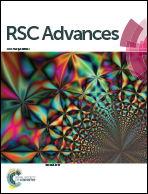Dual role of the reactant MOH (M=Li, Na or K) in the growth of ZnO quantum dots under a sol–gel process: promoter and inhibitor†
Abstract
ZnO quantum dots (QDs) with tunable size and photoluminescence can be achieved simply by controlling their growth during the sol–gel synthesis process. However, the role of alkali metal hydroxide MOH (M = Li, Na or K) as the reactant in the growth of ZnO QDs is still controversial. In this work, we carried out a comprehensive study on the growth of ZnO QDs by using different types of MOH as the reactant under different reaction temperatures and in different solvents. The results reveal that the growth of ZnO QDs is considerably governed by MOH through the co-effect of OH− and M+ ions, which can facilitate and hinder the growth, respectively. Further investigations suggest that the hindering effect caused by M+ cations is strongly dependent on the amount of OH− anions around the ZnO QD surface and follows the trend of Li+ > Na+ > K+. Moreover, the dual role of the reactant MOH can also be confirmed when altering reaction temperature and solvent. The photoluminescence of ZnO QDs shows size-dependence and can be easily tuned over a wide range from purple to yellow via adjusting the reaction parameters. This research establishes a fundamental understanding on the growth of ZnO QDs from the role of the reactant MOH point of view, which may benefit the controllable growth of ZnO QDs.


 Please wait while we load your content...
Please wait while we load your content...